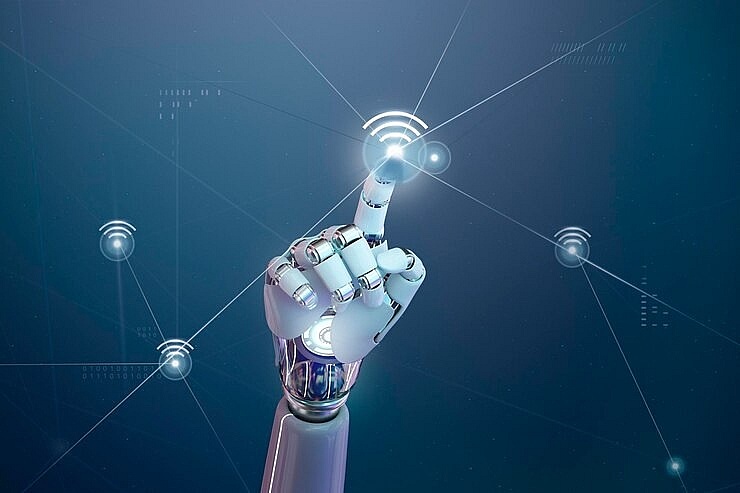Defining the role of AI in digital transformation
 |
| Defining the role of AI in digital transformation, illustration photo/ Source: freepik.com |
There are some differences between discriminative and generative AI. Discriminative AI distinguishes between objects or classes of objects, the technology behind facial recognition systems, spam filters and autonomous driving cars. Generative AI creates new data (text, images, video, audio, code) that looks and feels authentic.
Most of us used to think computers were great because they did the boring data-heavy jobs, the left-brain stuff. Numbers, spreadsheets, databases, great, let’s get a computer to save us time. We don’t mind computers getting better and faster at this stuff, at least, they will never be able to take over the creative side of things, such as creating art and writing poetry. How wrong we were.
AI’s role in the digital transition are critical. It enables automation of processes, increasing efficiency and reducing human error. It facilitates advanced data analysis, extracting valuable insights from large datasets for informed decision-making.
AI enhances digital security by detecting threats in real-time and implementing proactive measures to mitigate risks. It drives innovation in digital transformation, enabling organisations to adapt to evolving technologies and market demands. With generative AI, we cannot just differentiate between different types of inputs or data, but we can create completely new data.
Specifically, AI can help optimise energy production and consumption for greater energy efficiency, then reduce environmental impact. It can aid in waste management by enhancing recycling processes and less waste. Predictive analytics powered by AI can help in monitoring and protecting from disasters, then less damage. Predicting maintenance in a circular supply can make greater resource efficiency.
Applications operate for the transition in Europe in some sectors. In sustainable agriculture, Dahlia’s robots use AI to identify and remove weeds without chemicals. Such autonomous AI-driven machines promise a greener, more efficient farming future.
Elsewhere, Recyclebot enhances plastic recycling for improved efficiency and accuracy. With a focus on complex materials, it bridges human-robot collaboration in waste management. In energy efficiency, AI helps enhance grid efficiency, stabilises energy supply amid renewable fluctuations, and predicts maintenance needs, reducing outages, and optimising energy distribution.
Three different examples of applications of generative AI can be referenced to understand its role in the digital transition, all of which are from Germany. The first company has developed a robot that uses AI to detect and then remove weeds from fields. The obvious advantage here is that we do not have to use pesticides, but we can use robots that can distinguish between different types of plants, whether it is weed or whether it is the actual crop, so they will only pick out the weeds and not the crops.
The second company is in recycling. AI is being used as a research initiative at different universities and companies in Germany. They are testing the extent to which it can enhance recycling by detecting and understanding different types of waste, such as plastic, metals, or glass, and picking them with robots to recycle the waste much more efficiently.
The third is a German energy company which uses AI in a number of ways around grid efficiency, but also stabilising energy supply and predicting maintenance. Solar plants use it to understand which plants operate at what sort of levels in terms of production and efficiency.
However, we see some challenges, such as ensuring AI algorithms are fair, unbiased, and transparent; establishing ethical guidelines for development and deployment; addressing disparities in access and usage; and promoting inclusive AI education and training programmes to bridge the digital divide.
We have to balance data access for AI model training with privacy protection, and implement secure data handling practices. These models require significant resources like electricity and water, not only during development and training but also in their operational phase.
There are some highlights to implement AI in the transition. Training the workforce on AI skills to ensure a smooth integration of technologies in the transition efforts, and fostering public-private partnerships to leverage resources and expertise in effectively implementing related technologies, are the most important issues.
Then we should develop policy supporting the ethical and sustainable use of AI, and evaluate and act on the environmental footprint of models throughout their entire lifecycle.
 Digital transformation in health care - irreversible trend Digital transformation in health care - irreversible trend |
 US company steps up AI investment in Southeast Asia US company steps up AI investment in Southeast Asia |
(*) Andreas Pawelke, digital transformation consultant German Agency for International Cooperation
What the stars mean:
★ Poor ★ ★ Promising ★★★ Good ★★★★ Very good ★★★★★ Exceptional
Themes: Digital Transformation
- BIM and ISO 19650 seen as key to improving project efficiency
- Viettel starts construction of semiconductor chip production plant
- Vietnam, UN strengthen cooperation in digital technology, AI
- Vietnamese firms win top honours at ASEAN Digital Awards
- ASEAN Digital Ministers' Meeting opens in Hanoi
Related Contents
Latest News
More News
- VinFast sets record with 175,099 electric vehicles delivered in Vietnam in 2025 (January 15, 2026 | 14:24)
- Year-end shopping season faces rising uncertainty (January 14, 2026 | 18:11)
- State sector sees broad-based profit surge as major groups deliver strong results (January 13, 2026 | 17:34)
- HSBC forecasts Vietnam's GDP growth to hit 6.7 per cent in 2026 (January 13, 2026 | 17:33)
- Japfa maintains position in top 10 animal feed firms (January 13, 2026 | 10:18)
- Roadmap shaping up to phase out gas bikes (January 13, 2026 | 10:07)
- FDI momentum accelerates transformation of Vietnam’s plastics sector (January 11, 2026 | 07:00)
- UOB lifts Vietnam growth outlook to 7.5 per cent for 2026 (January 10, 2026 | 09:00)
- Exports cement role as central pillar (January 09, 2026 | 12:37)
- Siemens and NVIDIA expand partnership to build industrial AI operating system (January 09, 2026 | 10:04)

 Tag:
Tag:



















 Mobile Version
Mobile Version